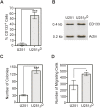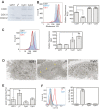CD133 is a marker of bioenergetic stress in human glioma
- PMID: 18985161
- PMCID: PMC2577012
- DOI: 10.1371/journal.pone.0003655
CD133 is a marker of bioenergetic stress in human glioma
Abstract
Mitochondria dysfunction and hypoxic microenvironment are hallmarks of cancer cell biology. Recently, many studies have focused on isolation of brain cancer stem cells using CD133 expression. In this study, we investigated whether CD133 expression is regulated by bioenergetic stresses affecting mitochondrial functions in human glioma cells. First, we determined that hypoxia induced a reversible up-regulation of CD133 expression. Second, mitochondrial dysfunction through pharmacological inhibition of the Electron Transport Chain (ETC) produced an up-regulation of CD133 expression that was inversely correlated with changes in mitochondrial membrane potential. Third, generation of stable glioma cells depleted of mitochondrial DNA showed significant and stable increases in CD133 expression. These glioma cells, termed rho(0) or rho(0), are characterized by an exaggerated, uncoupled glycolytic phenotype and by constitutive and stable up-regulation of CD133 through many cell passages. Moreover, these rho(0) cells display the ability to form "tumor spheroids" in serumless medium and are positive for CD133 and the neural progenitor cell marker, nestin. Under differentiating conditions, rho(0) cells expressed multi-lineage properties. Reversibility of CD133 expression was demonstrated by transfering parental mitochondria to rho(0) cells resulting in stable trans-mitochondrial "cybrid" clones. This study provides a novel mechanistic insight about the regulation of CD133 by environmental conditions (hypoxia) and mitochondrial dysfunction (genetic and chemical). Considering these new findings, the concept that CD133 is a marker of brain tumor stem cells may need to be revised.
Conflict of interest statement
Figures







References
-
- Griguer CE, Oliva CR, Gillespie GY. Glucose metabolism heterogeneity in human and mouse malignant glioma cell lines. J Neurooncol. 2005;74:123–133. - PubMed
-
- Griguer CE, Oliva CR, Gillespie GY, Gobin E, Marcorelles P, et al. Pharmacologic manipulations of mitochondrial membrane potential (DeltaPsim) selectively in glioma cells. J Neurooncol. 2007;81:9–20. - PubMed
-
- Griguer CE, Oliva CR, Kelley EE, Giles GI, Lancaster JR, Jr, et al. Xanthine oxidase-dependent regulation of hypoxia-inducible factor in cancer cells. Cancer Res. 2006;66:2257–2263. - PubMed
-
- Warburg O. On respiratory impairment in cancer cells. Science. 1956;124:269–270. - PubMed
-
- Modica-Napolitano JS, Kulawiec M, Singh KK. Mitochondria and human cancer. Curr Mol Med. 2007;7:121–131. - PubMed
Publication types
MeSH terms
Substances
Grants and funding
LinkOut - more resources
Full Text Sources
Other Literature Sources
Medical
Research Materials

